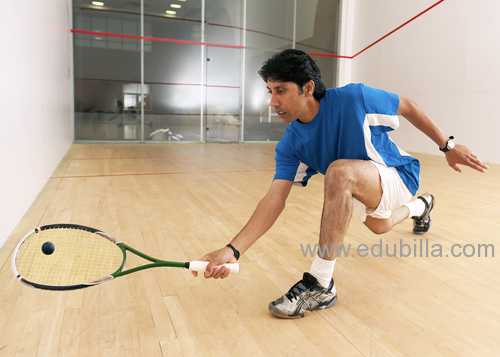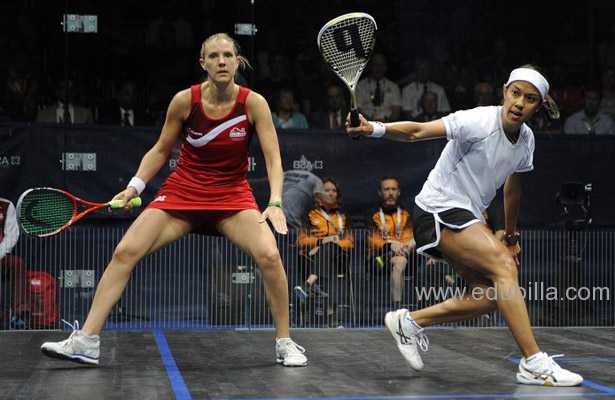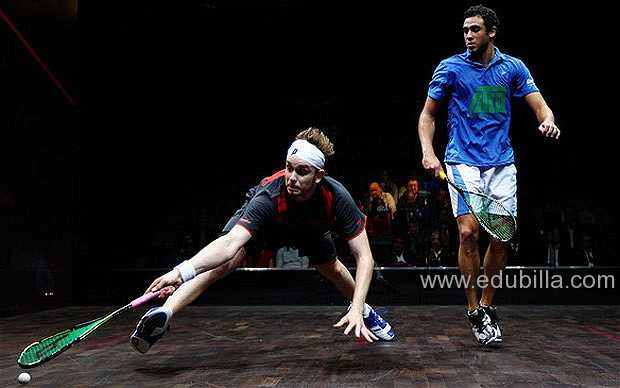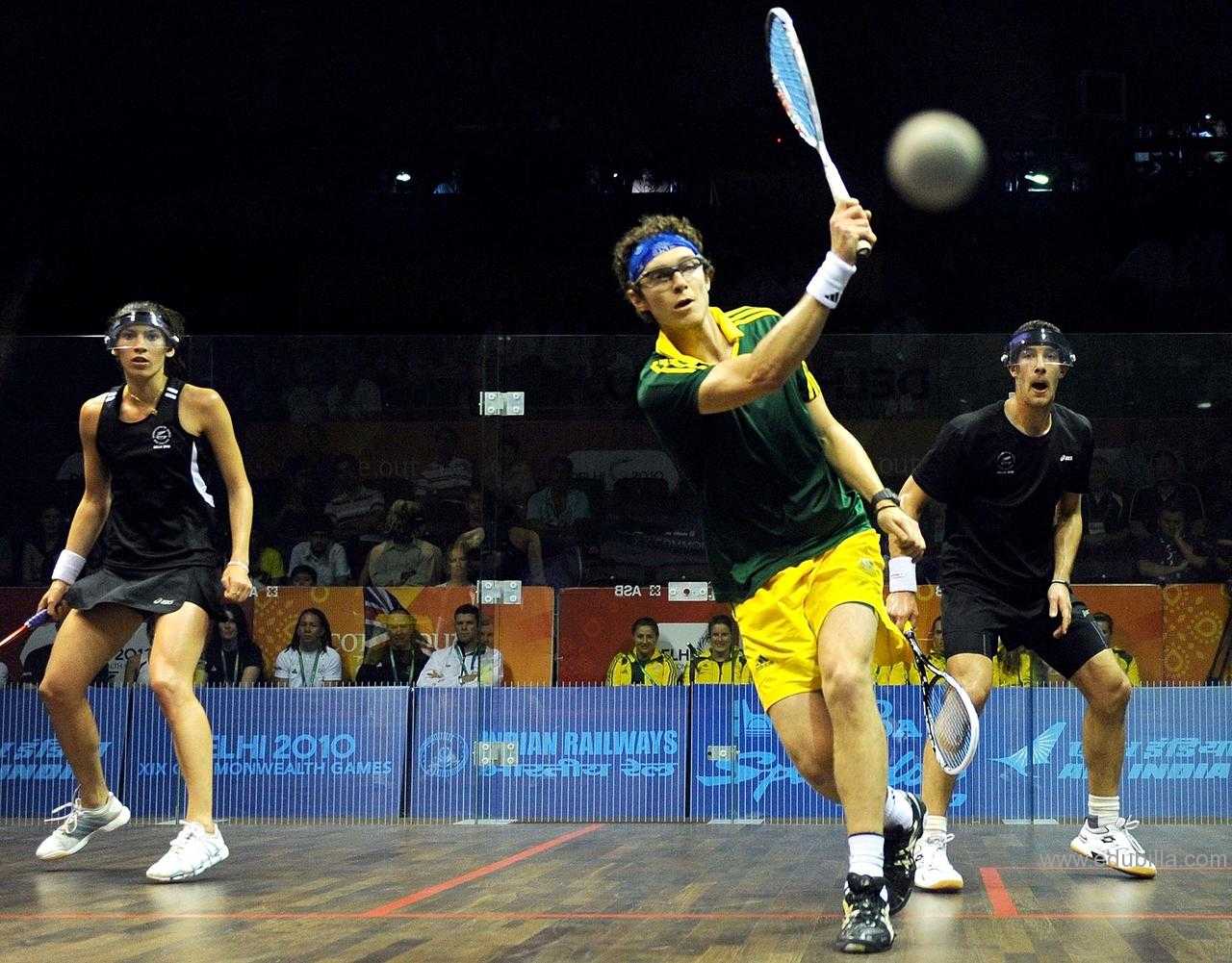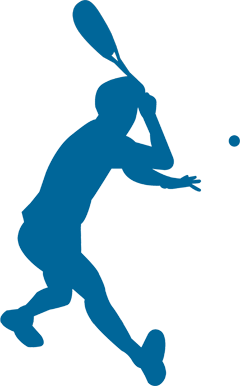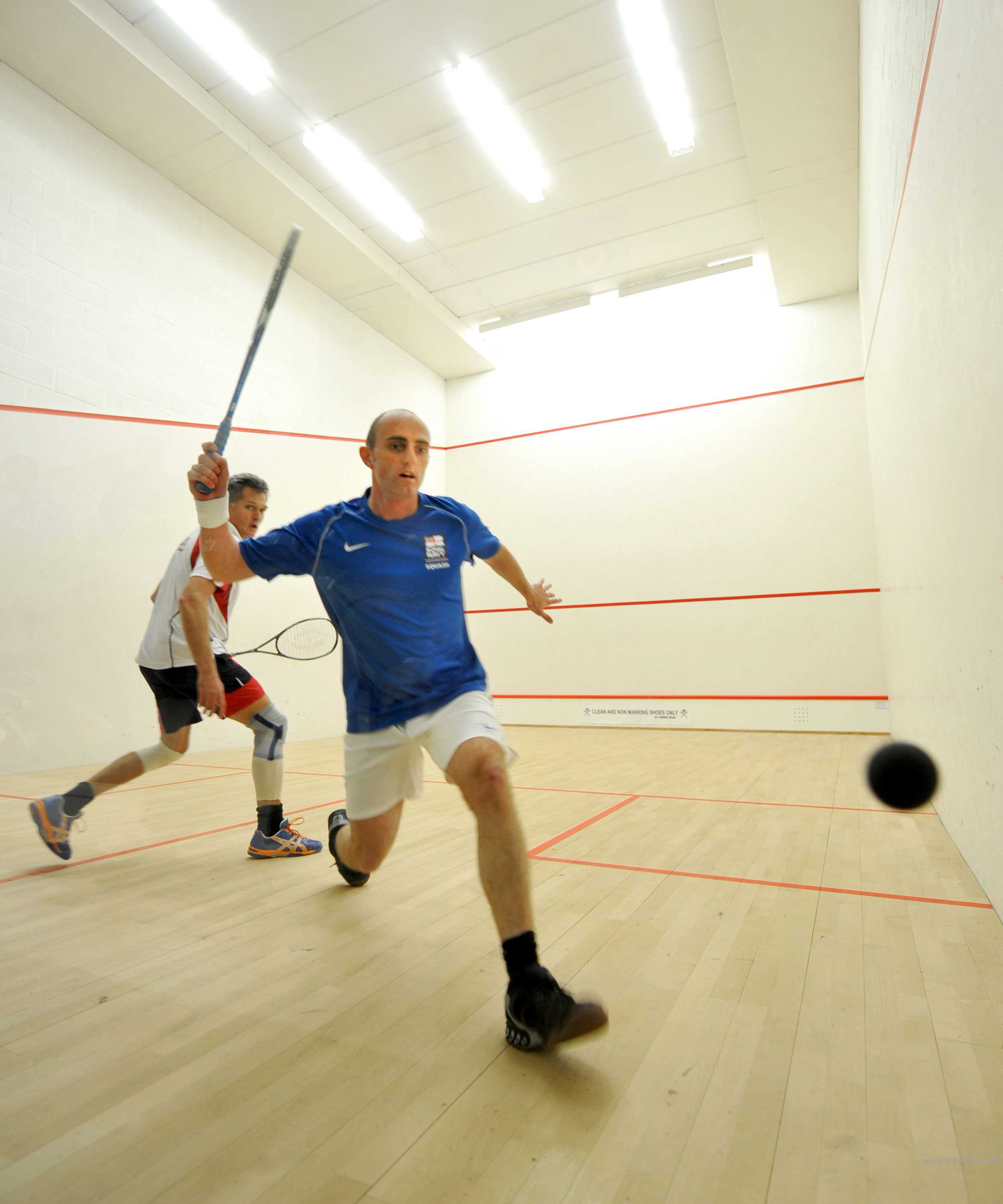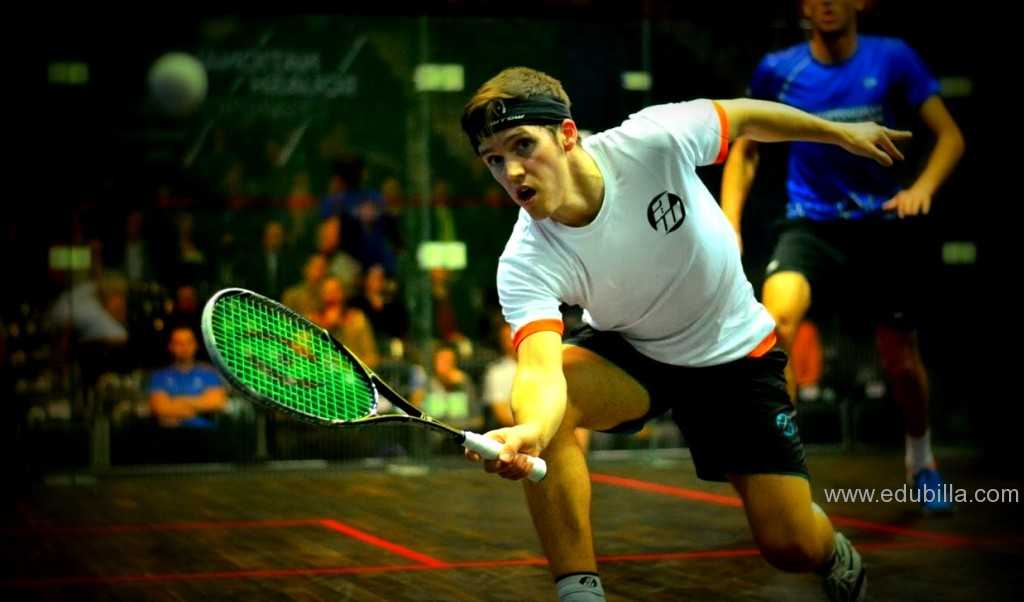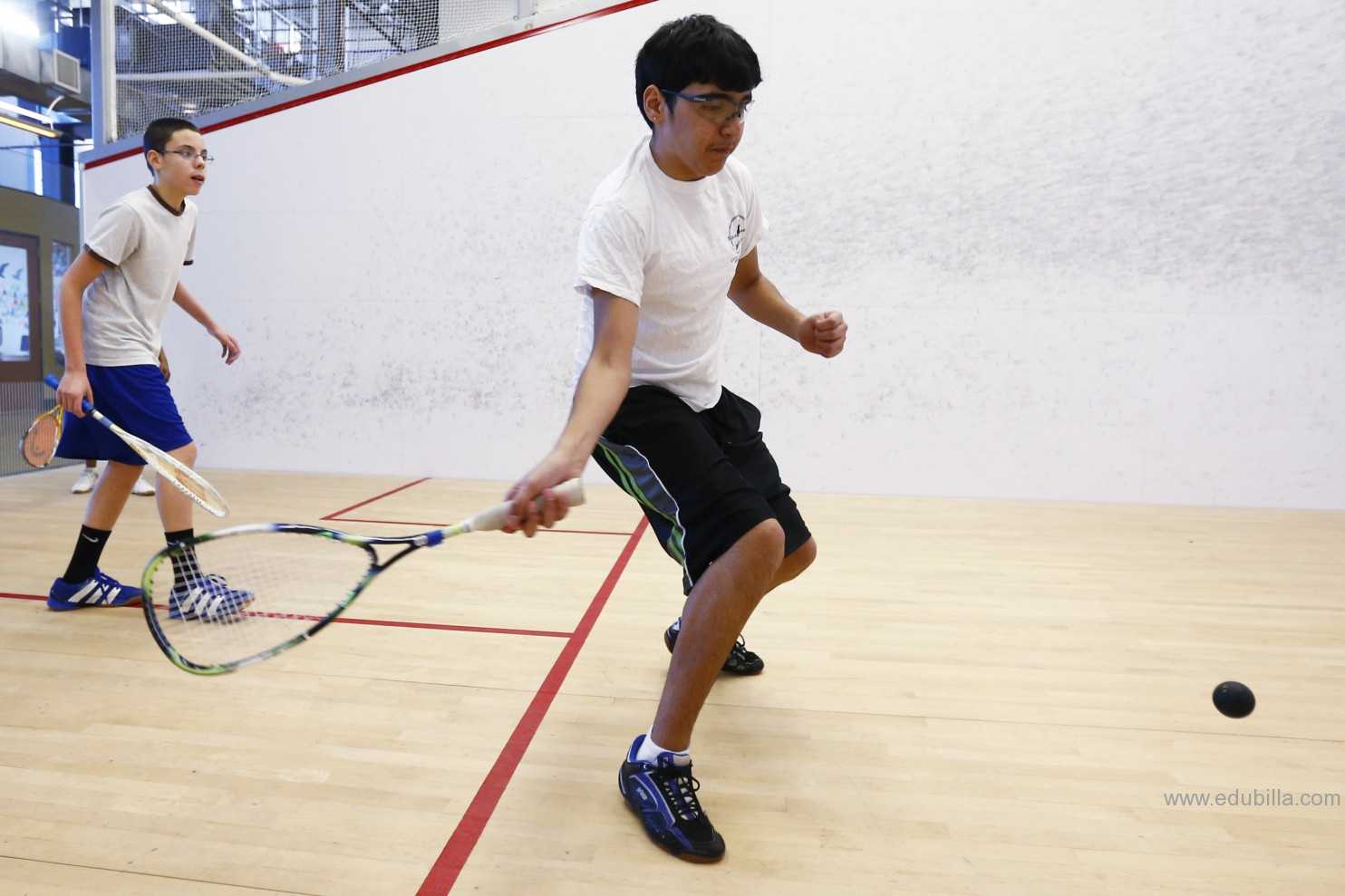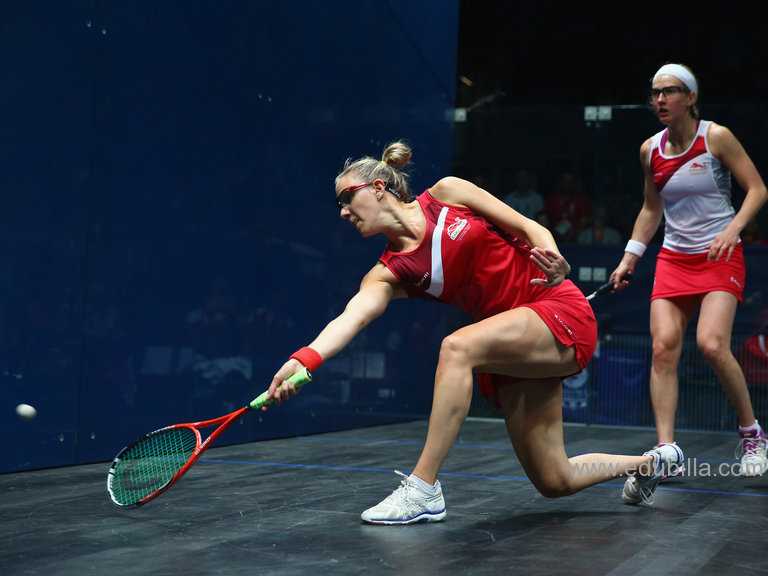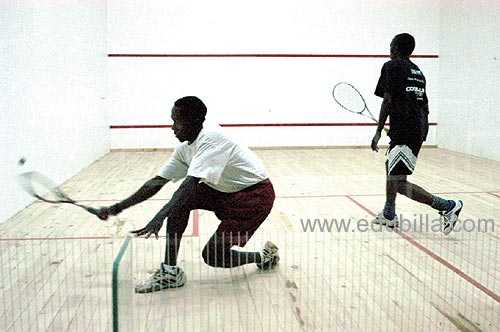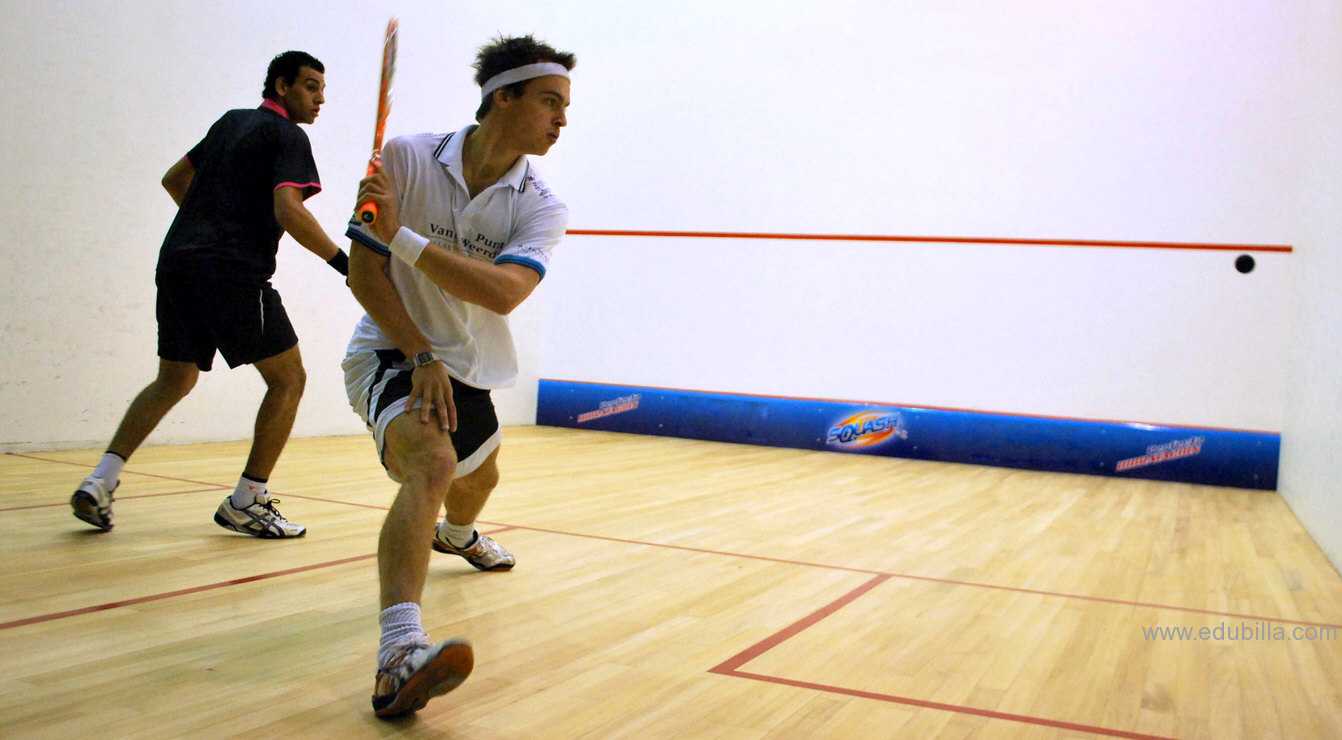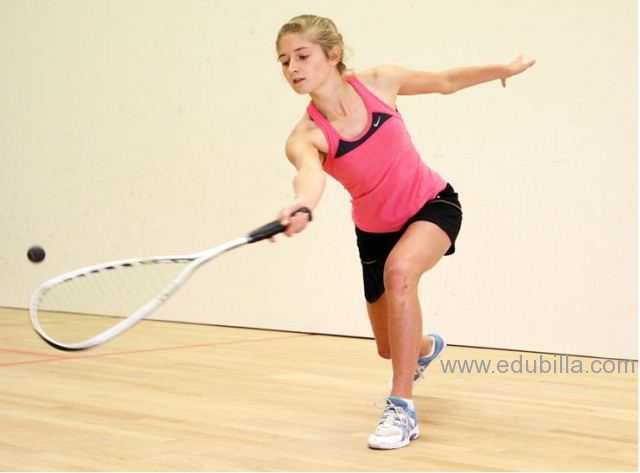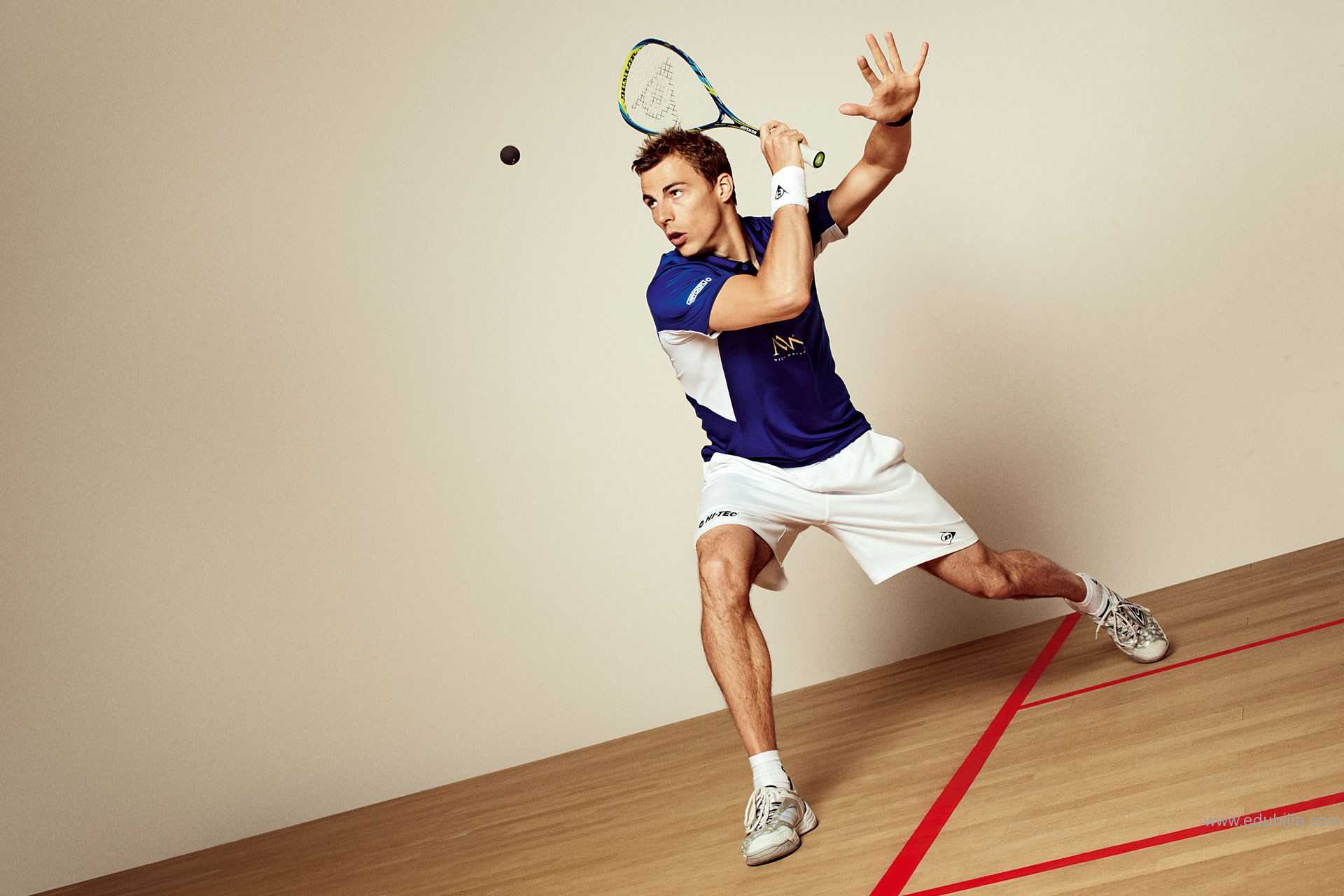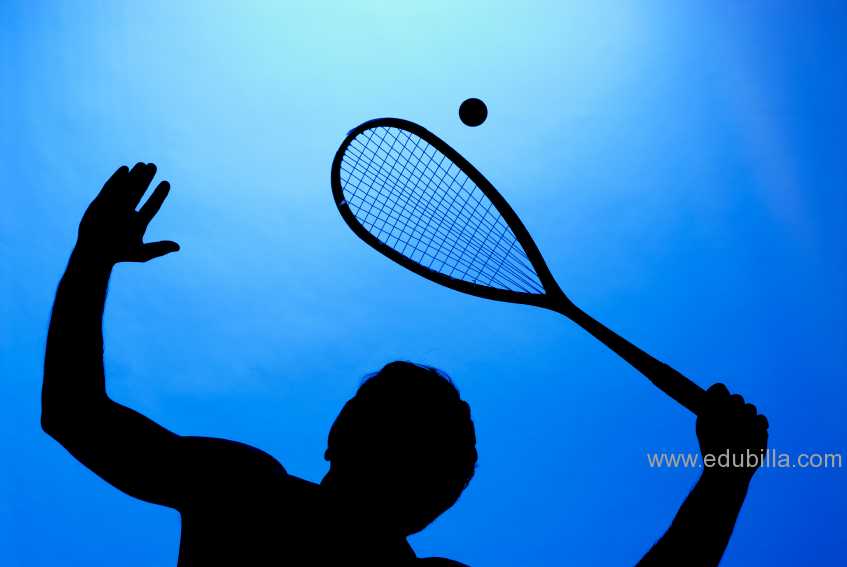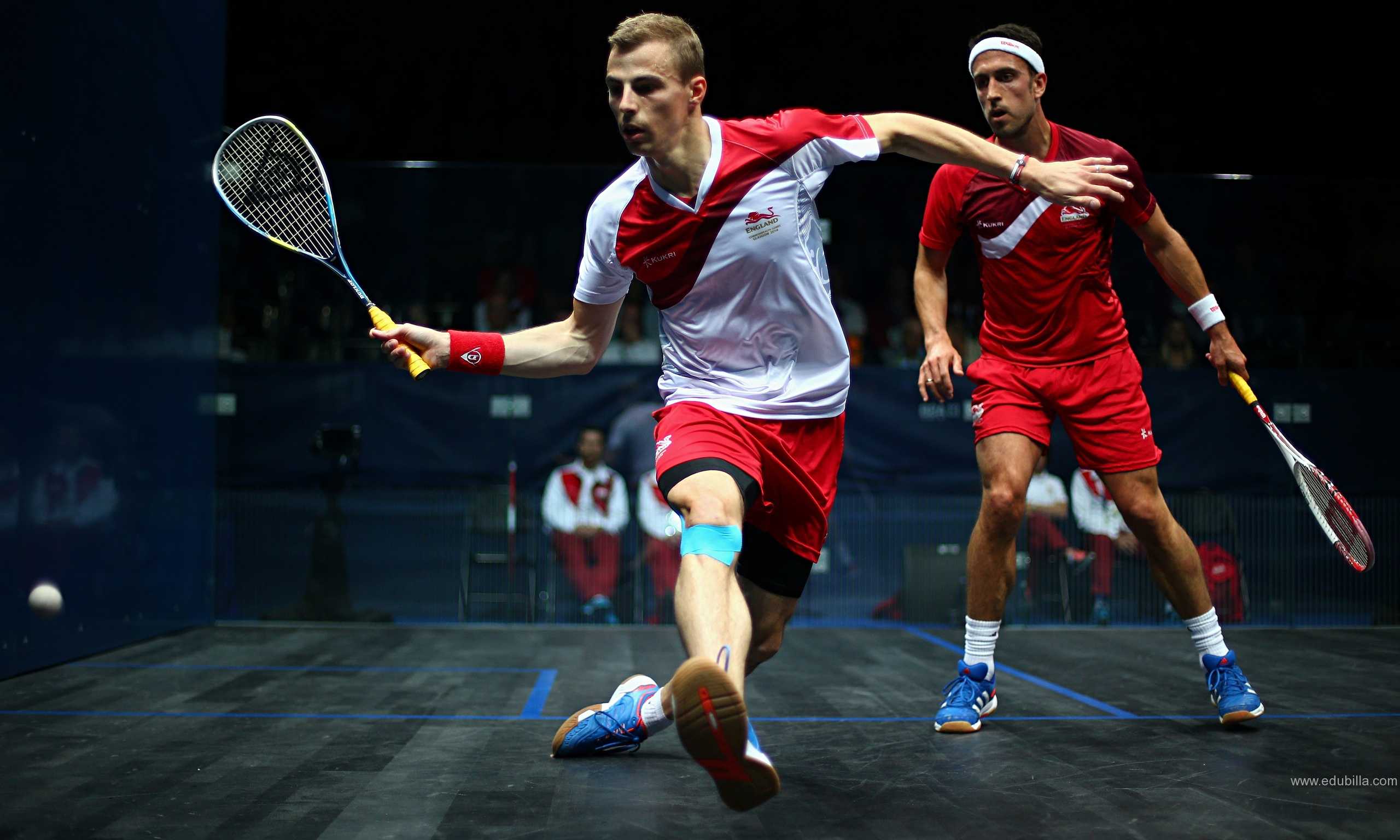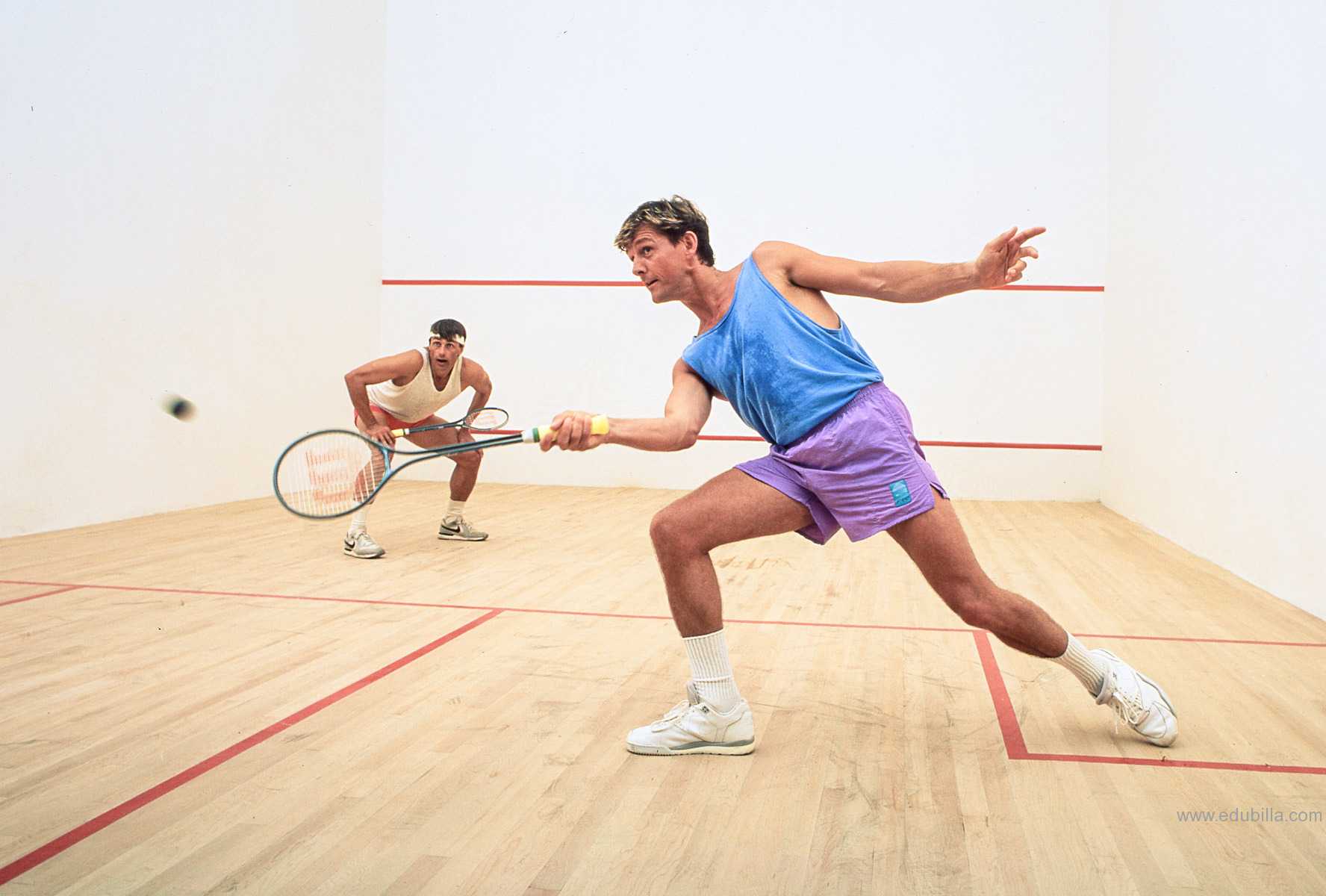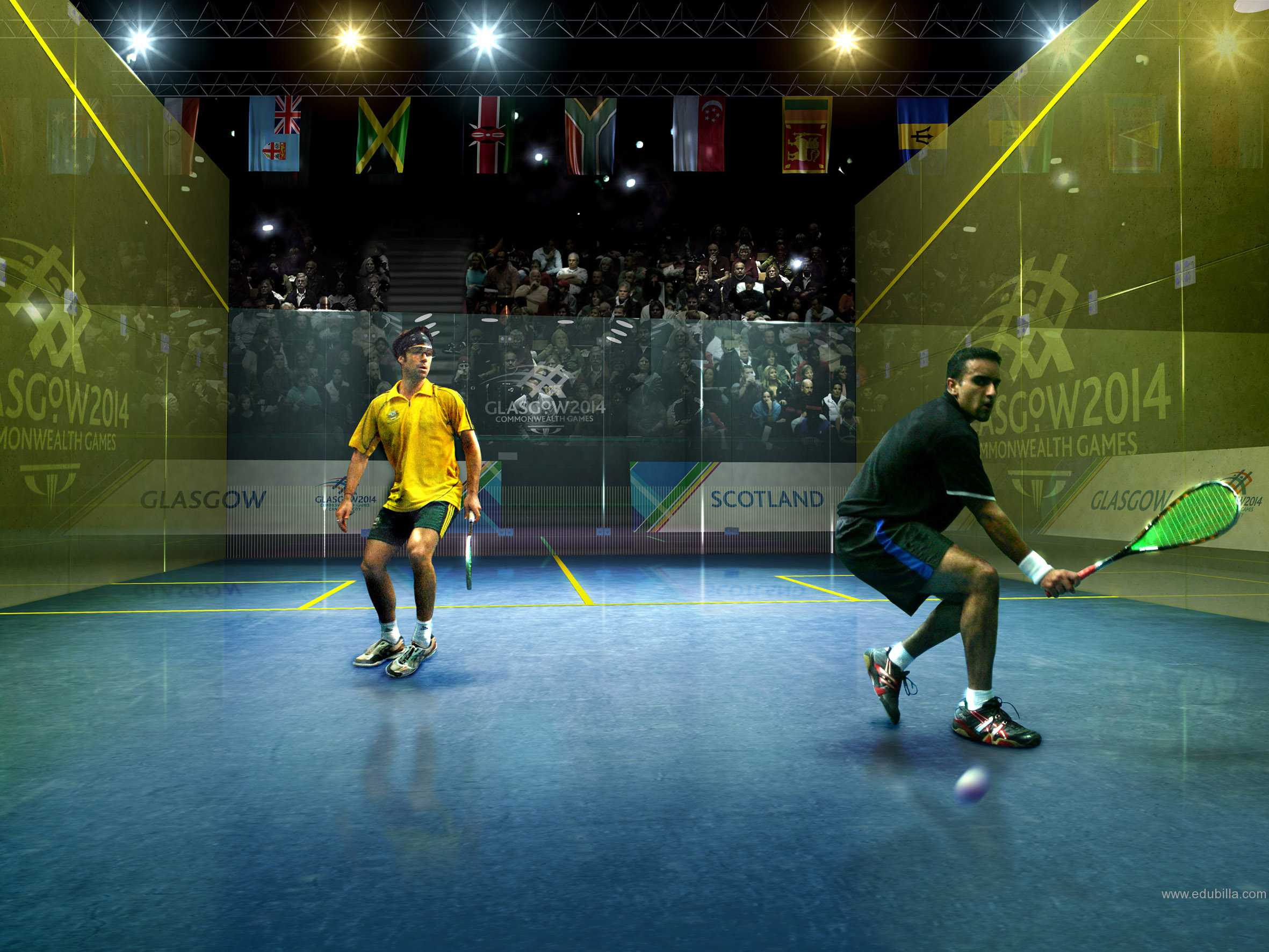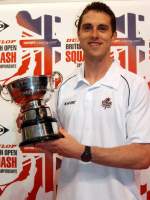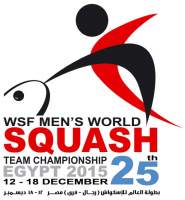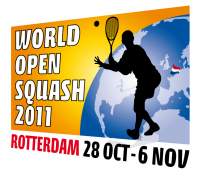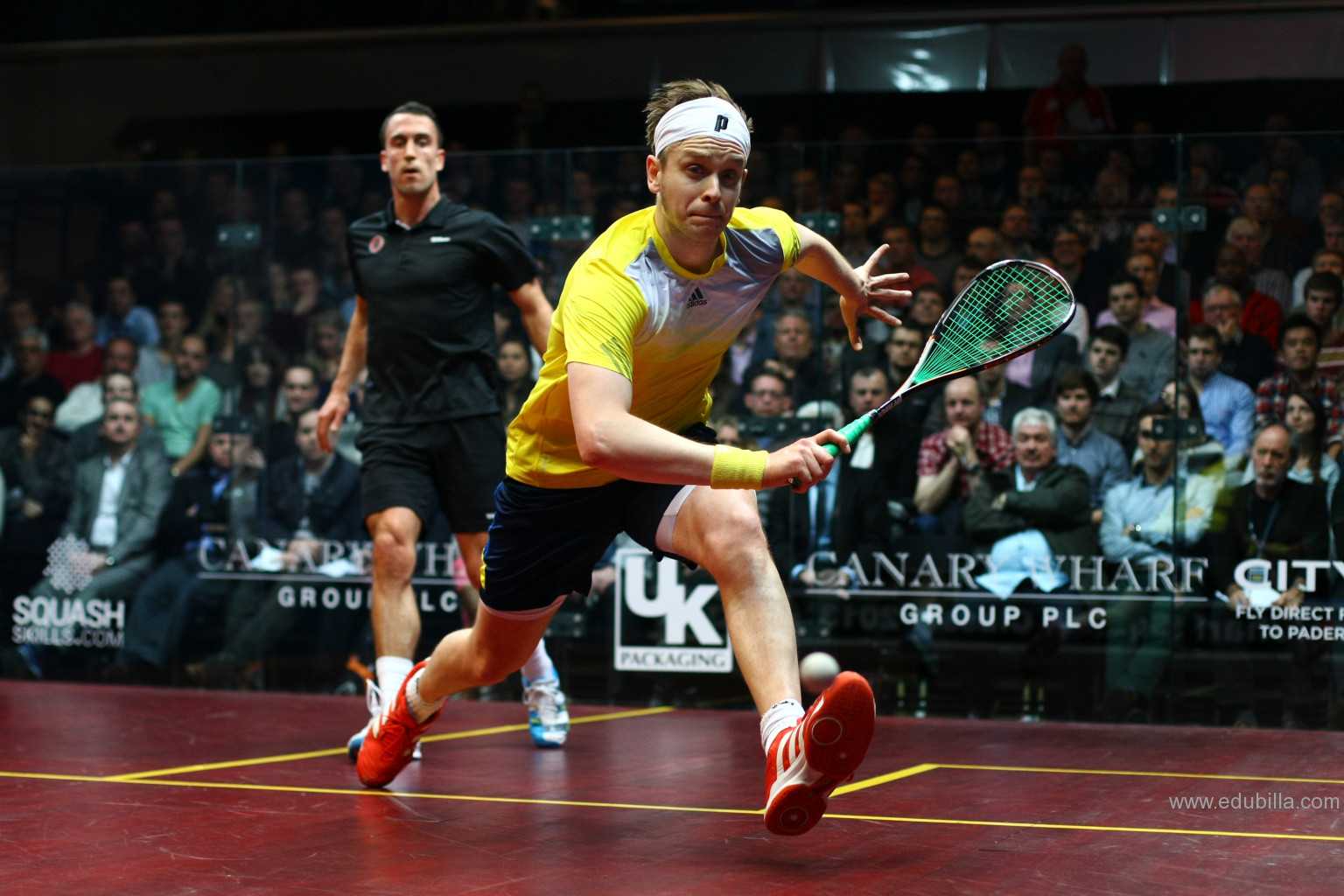
Overview Of Squash (sport)
Squash is a racquet sport played by two (singles) or four players (doubles) in a four-walled court with a small, hollow rubber ball. The players must alternate in striking the ball with their racquet and hit the ball onto the playable surfaces of the four walls of the court.The game was formerly called squash racquets, a reference to the "squashable" soft ball used in the game (compared with the harder ball used in its sister game racquets).
Squash Types:
Squash is a fun and exciting indoor sport that can be played at most gyms and recreational centers. In general, squash is played in two different forms:
Singles - Singles squash is played by two players (one per side), competing against eachother. Much like tennis, players volley the ball back and forth attempting to make their opponent miss, and points are scored when you are serving (or starting play).
Doubles - Doubles squash is played with two teams of two players per side. The rules are similar to singles squash, however, the techniques are slightly different. Players must understand the strategies of their teammate and work together to achieve success.
Scoring:
- In the traditional, British system you can only score points when you are serving.
- When the player receiving serve wins a rally, the score does not change, but he or she becomes the server.
- So if you are facing serve, you need to win two rallies to register a point.
- A match is the best of five games, and for a player to win a game they must reach nine points.
- If the score reaches eight-all, however, the player who is not serving at the time can choose whether to play to nine points or to 10 points.
- During points, a player can be impeded or unsighted as they try to play their next shot, and can ask for a let.
- If the referee decides this is deserved, he or she can order the point to be replayed, or award the rally to the player who has been affected.
Tactics:
- Experienced players know that the best way to win a game of squash is to make the opponent to do the running.
- England's Peter Nicol, a former world number one, says: "If you're at the "T", you're at the centre of the court, you're in control and generally you're in a position to win the game."
- Keeping the ball low lessens the chance of your opponent reaching it before it bounces twice.
- Nicol says: "The back two corners are the most important areas on a squash court. If your opponent does manage to get it out of there, then you're in a strong position to control the rally after that.
- "The other place where the ball doesn't bounce very well is the join between the wall and the floor."
Popularity:
- According to the World Squash Federation, as of June 2009, there were 49908 squash courts in the world, with 188 countries and territories having at least one court. England had the greatest number at 8,500. The other countries with more than 1,000 courts, in descending order by number were Germany, Egypt, the United States of America, Australia, South Africa, Canada, Malaysia, France, the Netherlands, and Spain. Today, The United States has the fastest growing squash participation. There are an estimated 20 million squash players world-wide.
- As of June 2009, there were players from nineteen countries in the top fifty of the men's world rankings, with England and Egypt leading with eleven each.The women's world rankings featured players from sixteen countries, led by England with eleven.
- The men's and women's Professional Squash Association tour, men's rankings and women's rankings are run by the Professional Squash Association (PSA).
- The Professional Squash Tour is a tour based in the United States.
Game Rules

The basic rules of squash are fairly simple. First the winner of the toss gets to choose which side they want to serve from and alternates sides until they lose a point. The toss is typically done by spinning the racquet, with one player guessing whether the racquet will land up or down based on the direction of the logo at the end of the grip. The ball can hit any number of walls ( i.e sidewall, backwall ) but must eventually hit the front wall before bouncing on the floor. A rally ( the exchange of shots ) ends when one of the following occurs:
- The ball bounces twice
- The ball hits the tin
- The ball is hit outside the out lines
- Interference resulting in a stroke, i.e. point to the obstructed player.
The serve is done by having at least one foot in the service box, then hitting the ball to the front wall, above the service line and having it bounce in the opposite quarter-court. The receiver can stand anywhere as long as they do not interfere with the server. Only one serve is allowed. There is no second serve as in tennis.
Your opponent has the option of volleying return your serve before it hits the ground. After hitting the front wall first, the ball may hit any other number of walls before landing in the opponent’s quarter court. However, a serve is illegal if it hits any sidewall before hitting the front wall! Following the serve, the ball can hit any number of sidewalls before hitting the front wall.
The red lines mark the out of bounds of the court. So all shots must be below the lines. If the ball touches the line it is considered out!
Scoring is to 11 or point-a-rally ( PAR ), where every rally is a point, regardless of who served. So if you serve and lose the rally, then your opponents get a point and gets to serve. The professionals play best of five games , PAR scoring to 11. Where the score reaches ten all, the game will be won by two clear points (which will be expressed as 11-10, irrespective of the actual score ).
You also have traditional English scoring to 9 points, where only the server can win a point. This means if you serve the ball and lose the point, then your opponent gets to serve and the score does not change. If you win the point , then you get a point and get to serve from the next side. When service changes it is often called 'hand-out'. When hand-out you can pick which side to serve from, after which you alternate sides if you continue to win points. The first player who gets to 8-8 chooses 9 or 10, called set 1 or 2.
The 11 point scoring is now the official scoring for squash so one should only use this to avoid confusion.
Some not-so-obvious rules of squash are you can not carry the ball or hit the ball twice, but you can make several attempts at striking the ball as long as only contact is made once.
Understanding interference
Regarding interference, one should always say "Let please" whenever you sense interference may occur. In the interest of safety one should never play the shot and allow the interference to occur. If your opponent is interfering with your path to the ball, it is usually a "Let" or play the point again. If your opponent is interfering with your direct swing to the ball, then it should be "stroke" or your point. There are a lot of grey areas and many other situations that could change the call. With experience you will learn what is let , no let, and stroke. As a beginner it is best to play a let on most interferences.
In squash you must make every effort to clear your shot to give your opponent direct access to the ball once you have played it. In other words you can not play your shot and remain standing directly in the path your opponent would take to retrieve your shot.
When interference does occur it results in either a "Let" which is to replay the point or a "Stroke" which is a point to the person who's shot was obstructed. Keep in mind the following rule of thumb regarding Let and Stroke.
Interference far from ball (>1m):
Could have got to it --> LET (replay point)
Otherwise --> NO LET
Interference close to ball (<1 m):
Could have hit it --> STROKE (i.e your point!)
Otherwise --> LET
In the interest of safety you must NEVER attempt any shot that has a risk of either the ball or the racquet hitting your opponent. The correct thing to do is to hold your shot and ask for a "let". In the case where your shot would have hit your opponent you can ask 'Let Please'. Your opponent should then award you the stroke if there is no referee.
If the ball hits the opponent, it depends where the ball is going. If going to front wall then stroke, if going to side wall then let. This is the simple answer though there are other situations that can result in other calls.
Equipments Need For Squash (sport)
- Squash ball
- Squash racquet
- Squash goggles
- Squash Gloves
- Racquet Stringing
History Of Squash (sport)
The use of stringed racquets is shared with tennis, which dates from the late sixteenth century, though is more directly descended from the game of racquets from England. In "racquets", instead of hitting over a net as in sports such as tennis, players hit a squeezable ball against walls.Squash is a racquet sport that requires great skill and stamina, with a soft ball that favors finesse over power. It is played all over the world by elite players in circuit tournaments and by recreational players looking for a fun workout.
Etymology:
The name “squash” derives from its soft ball that squashes when it hits the wall, unlike the harder ball used in its parent game, Racquets.
Squash Timeline:
- 1820-The game made its way to Harrow and other select English schools around 1820, where the pupils discovered that a punctured Racquet ball “squashed” on impact.
- 1830-Squash was invented in Harrow School out of the older game racquets around 1830 before the game spread to other schools, eventually becoming an international sport.
- 1864- Squash proved very popular and in 1864 the first four squash courts were constructed at Harrow school and Squash was officially founded.
- 1880-The game was introduced to North America in the 1880s.
- 1884-The first squash court in North America appeared at St. Paul's School in Concord, New Hampshire in 1884.
- 1899-One of Vancouver's pioneer players, Bimbo Sweeney, learned to play the game in 1899 on a court built to English standards by the Honourable Cecil Edwards at his Vancouver residence.
- 1980-In the 1980s, construction shifted to lighter, carbon-based materials (such as aluminium and graphite) with small additions of components like Kevlar, boron and titanium. Natural "gut" strings were also replaced with synthetic strings.
- 1904-In 1904 in Philadelphia, Pennsylvania, the earliest national association of squash in the world was formed as the United States Squash Racquets Association, (USSRA), now known as U.S. Squash.
- 1907-In April 1907 the Tennis, Racquets & Fives Association set up a sub committee to set standards for squash.Then the sport soon formed, combining the three sports together called “Squash”.
- 1912-The first Canadian Men's Singles Championship was held at the Montreal Racket Club on March 20, 1912, but the Canadian Squash Racquets Association was not formed until 1915.
- 1923-In January 1923 the Royal Automobile Club hosted a meeting of delegates from English clubs where squash was played and formed a "Squash Rackets Representative Committee."
- 1922-The Lapham Cup matches between Canada and the U.S.A., dating back to 1922, are believed to be one of the oldest amateur sporting events between two countries, having been played for 90 consecutive years.
- 1924-International competition with the United States began with the sending of a British team to the United States in 1924, though such competition was later hampered by differences in British and American courts, balls, and methods of scoring.
- 1928-In December 1928 the Squash Rackets Association was formed to run squash in Great Britain.
- 1967-In January 1967 representatives from seven nations (Australia, Great Britain, Egypt, India, New Zealand, Pakistan and South Africa) met in London and formed the International Squash Rackets Federation (ISRF).
- 1985-The ISRF was amalgamated with the Women's International Squash Federation in 1985.
- 1992-In 1992 the name of the Federation was changed to the World Squash Federation (WSF), finally recognising that the sport had been universally referred to simply as "Squash", rather than "Squash Rackets".
- 1995-Squash is also a regular sport at the Pan American Games since 1995.
- 1998-Squash has been featured regularly at the multi-sport events of the Commonwealth Games and Asian Games since 1998
- 2000-The "double-yellow dot" ball, introduced in 2000, is the competition standard, replacing the earlier "yellow-dot" ball. There is also an "orange dot" ball.
- 2009-According to the World Squash Federation, as of June 2009, there were 49908 squash courts in the world, with 188 countries and territories having at least one court. England had the greatest number at 8,500. The other countries with more than 1,000 courts, in descending order by number were Germany, Egypt, the United States of America, Australia, South Africa, Canada, Malaysia, France, the Netherlands, and Spain.
- 2016-The Federation leads its Member Nations in programmes for the development of the sport and is currently working with the IOC towards the target of having Squash included as a sport on the programme of the Olympic Games in the year 2016.
- 2012-2020-Squash narrowly missed being instated for the 2012 London Games and the 2016 Rio de Janeiro Games (missed out again as the IOC assembly decided to add golf and rugby sevens to the Olympic programme).Squash also missed out as an event in the 2020 Olympic Games.
Origin Of Squash (sport)
Invention of Squash:
Squash was invented in Harrow School out of the older game racquets around 1830 before the game spread to other schools, eventually becoming an international sport. The first courts built at this school were rather dangerous because they were near water pipes, buttresses, chimneys, and ledges. The school soon built four outside courts. Natural rubber was the material of choice for the ball. Students modified their racquets to have a smaller reach to play in these cramped conditions.
First Book:
The first recorded reference to “Squash”, other than in Harrow school, appeared in 1890 in the English book “The Badminton Library of Sports and Pastimes” written by the Duke of Beaufort. Eustace Miles, a world championship at both Tennis and Rackets, wrote the first book on Squash in 1901; stating that the sport was enjoyed by thousands of players in various parts of the world. By that time there were courts in schools and universities in England and some also in private houses.
First Championship:
The first professional Squash Championship was held in 1920 in England, when C.R. Read (Queens Club) beat A.W.B. Johnson (RAC Club).In 1923 H.A.L. Rudd, writing in “Baily’s Magazine”, forecast that Rackets would lose many players to Squash with the arrival of the first English Amateur Championships. He was concerned at this prospect as he considered Rackets to be a “manlier” game; Squash afforded a good “sweat” but did not demand the same skill as Rackets, in his opinion. Rudd’s forecast proved to be only too correct as Squash grew rapidly and soon left its parent sport far behind in popularity.
First National Associations :
The first discrete national associations to be formed were the United States Squash Racquets Association in 1907 and the Canadian Squash Racquets Association in 1911. In England the game was regulated by a Squash sub-committee of the Tennis and Rackets Association from 1908 until it gained full status as the Squash Rackets Association in 1928.
First National Doubles Championships:
The North American players were also the first to appreciate the virtues of Doubles Squash, with the hardball being used on a court measuring 45 feet long by 25 feet wide. The first National Doubles Championships were held in 1933 and Hardball Doubles continues to thrive even though the singles version now holds only a minority of play.
First Squash Courts:
Australia-The first Squash courts in Australia were established in 1913, at the Melbourne Club in Victoria.The first Australian Championships were held, for men in 1931 and women in 1932, they were, in reality, State Championships for Victoria.
South Wales-In New South Wales the first court was built just after the first World War, by Mr. Bjelke-Petersen, the uncle of the former Queensland Premier, Sir Joe Bjelke-Petersen. The New South Wales SRA was formed in 1937 and the first pennant competition in Sydney commenced in July 1939.
Germany-In Germany Squash was born twice! Its first cradle was in Berlin in 1930 when the first four courts were built by Dr. Ernst von Siemens, head of the technology department of the electronics company which bore his name, and he started regular company staff activities and even foreign competitions on the “wall-play-halls”.
North America-The first squash court in North America appeared at St. Paul's School in Concord, New Hampshire in 1884.
Governing Bodies
World Squash Federation (WSF):
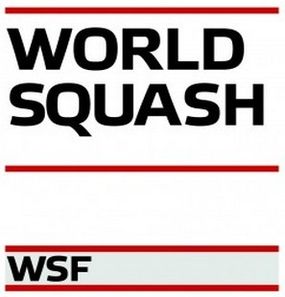
- The World Squash Federation (WSF) is the international federation for squash, an indoor racquet sport which was formerly called "Squash rackets."
- It is based in Hastings in England. As of 2009 it has 145 member federations. It is bidding for squash to be added to the Olympic program for the 2020 Summer Olympics.
- The first squash court was built in England in 1864; there are now around 50,000 courts in more than 185 nations worldwide. To harness this growth and to promote and co-ordinate the sport, the International Squash Rackets Federation (ISRF) was formed in 1967, its name being changed in 1992 to the World Squash Federation (WSF).
- The WSF is recognised by the International Olympic Committee (IOC) as the International Federation (IF) for squash. The WSF is a member of the SportAccord and the Association of the IOC Recognised International Sports Federations (ARISF).
Membership:
The WSF has 145 Members, all of whom are National Associations of squash, recognised by their National Olympic Committee (NOC) or Ministry of Sport as the sole and undisputed governing body for the sport in the country. Members are required to join one of the five Regional Federations which are an integral part of the WSF structure. Members receive a number of votes to be used at General Meetings depending on the number of squash courts in their country.
Continental Association:
- Asian Squash Federation (ASF)
- European Squash Federation (ESF)
- Squash Federation of Africa (SFA)
- Oceania Squash Federation (OSF)
- Federation of Panamerica (FPS)
Events:
Seniors' Events
- World Games
- World Open Squash Championships
- World Team Squash Championships
- World Doubles Squash Championships
Junior Events
- World Junior Squash Circuit
- World Junior Squash Championships
- University Events
- World University Squash Championships
Masters' Events
- World Masters Squash Championships
To Visit WSF Click Here.
Awards Related To Squash (sport)
PSA Awards:
The PSA Awards are presented annually by the Professional Squash Association, the organization which organizes the men's world squash circuit.
WSA Awards:
The WSA Awards (formerly WISPA Awards) are presented annually by the Women's Squash Association, the organization which organizes the women's world squash circuit.
University of Birmingham Sport Awards:
The Sports Ball which is run by the VP Sport and the Guild of Students brings together sports clubs and active-based societies to recognise their development and participation to sport at the university.
The Awards
Victoria Wesley Award:
The Victoria Wesley Award is presented to individuals who have put in outstanding contribution and added value to sport at the University of Birmingham.
Student Leadership Award:
The student leadership award recognises outstanding leadership qualities amongst our student volunteers.
Volunteer Coach of the Year Award:
As one of the valuable contributions to UBSport comes from our Volunteer Coaches, this award recognises the commitment given to provide outstanding coaching services to our talented athletes, allowing them every opportunity to perform at their best.
Coach of the Year:
An award to recognise an outstanding performer from within one of more than 100 paid coaches.
Club of the Year:
The award is split into the three areas of development, improvement and performance to recognise the variety of ways in which clubs work.
Team of the Year:
Specific to teams, this award recognises outstanding performances on the pitch.
Sports Person of the Year Award:
The highest individual accolade awarded by UBSport in recognition of the very highest sporting level.
US Squash Awards:
US Squash honors the special and significant contributions individuals have made to the game of squash through a number of special awards and recognitions.
US Squash Categories:
- President’s Cup
- W. Stewart Brauns, Jr. Award
- Achievement Bowl
- A. Carter Fergusson Grand Master Honor Roll
- Feron’s Wedgwood Sportsmanship Trophy
- Men’s Sportsmanship Award
- DeRoy Junior Sportsmanship Award
- William T. Ketcham, Jr. Most Improved Award
- USOC Athlete of the Year
- USOC National Coach of the Year
- USOC Developmental Coach of the Year
- USOC Volunteer Coach of the Year
Sample Documents Of Squash (sport)
-Muhammad Ali


